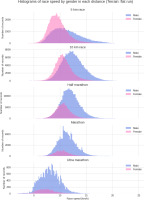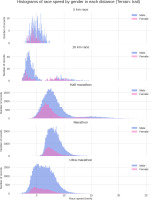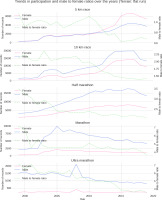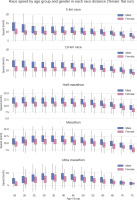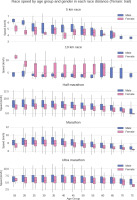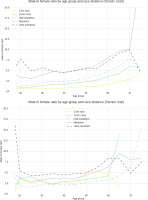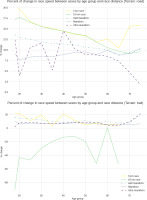Introduction
Sports participation in Switzerland has increased [1, 2], with running among the top five most practiced sports, after skiing, mountain biking/cycling, swimming, and hiking/walking [2]. The interest of the Swiss population in these sports is related to the natural landscape of the country, which includes mountains, forests, and trails, that facilitate engagement in outdoor physical activities [3]. In addition, an increase in the number of running events hosted in Switzerland is related to the interest in these sports [4].
Studies on participation trends in Switzerland showed running to be popular among younger individuals,women, and those with higher education levels [5]. In this context, it is important to note that women participated in the Boston Marathon only after 1972 [6]. As shown for runners from other countries [7, 8], the main motives related to the practice of running in Switzerland were health and improvement of physical fitness [9]. Notwithstanding, some runners use running as a competitive activity, engaging in weekly training sessions to improve performance [10].
Despite the higher volume of research related to road running, mountain and trail races have started to attract the attention of researchers over the last few years [11, 12]. trail running consists of running on courses with positive and negative slopes varying in altitudes, distances, surfaces, and courses [13, 14]. Physiological demands differ between terrain types. For example, previous studies highlighted that running in mountain races slowed runners more than their counterparts in duration-matched road races, presenting a maintenance or decline in heart rate during the second half of halfmarathon and marathon events [15], as well as presenting specific demands under different altitudes [16] and unpredictable weather conditions [17].
Despite the popularity of running in Switzerland [11, 12, 18, 19], little evidence is available regarding participation by gender, age group, race distances, and performance indicators for both road and trail races. Based on the geographic and natural characteristics of Switzerland, as well as the interest of the population in running practice, Switzerland was considered the ideal case scenario to compare road and trail running. Therefore, our study aimed to map running trends, including participation and performance in both terrains by both sexes. Based on previous findings, we hypothesized a higher participation in short distances (i.e., 5 km, 10 km) for women in road races. In terms of performance, we expected a higher variability among runners of both sexes competing in trail races.
Material and methods
Data set and data preparation
Data from 5 km, 10 km, half-marathon, marathon and ultra-marathon races held in Switzerland between 1999 and 2019 were collected from different sources such as ‘swiss-running’ (www.swiss-running.ch), ‘runme’ (www.runme.ch/de/laufkalender/schweiz), ‘datasport’ (www.datasport.com/de/sportevents/run- ning) and the official website of Deutsche Ultramar- athon-Vereinigung (‘DUV’) (https://statistik.d-u-v.org). A total of 1,149,182 race records (788,818 from men and 360,364 from women) competing in five different race distances (5 km, 10 km, half-marathon, marathon, and ultra-marathon) in 243 different race events over 20 years (1999-2019) were considered. Ultra-marathon, distance-limited (longer than 42.195 km), and time-limited (6 hours and longer) events were combined. Data extracted included the athletes’ gender, age, race distance, and terrain (road or trail).
Statistical analysis
The data records were stratified by sex (male, female), age groups, and type of terrain (road or trail), from which we calculated descriptive statistics such as group counts (participants) and race speed metrics (mean, standard deviation, min and max values). Histograms of race speeds by sex in each distance were plotted to assess the approximate normality of the data. We used box plots to graphically represent the heterogeneity of the data within and between groups and provide a base for comparison. The statistical significance of the differences between groups was tested with two-sample Kolmogorov-Smirnov (K-S) tests. The confidence interval was set at 95%. Additionally, the male-to-female ratio was calculated as male records/ female records, and the difference in speed between sexes was calculated as 100 x (male speed - female speed)/male speed. Furthermore, line plots illustrate these latter calculations. All data processing and analysis were done using Python (www.python.org) and a Google Colab (Jupyter) notebook (colab.research. google.com).
Results
A total of 1,149,182 race records (788,818 from men and 360,364 from women) were analyzed, from 408K different runners. Of the race records analyzed, 948,054 were from road races, while 210,128 corresponded to trail races. Below, the histograms of running speeds by race distances and terrains showed differences in data distribution between the sexes (Figures 1 and 2). A higher number of women were recorded competing in road-based 5 km races. Both sexes presented similar distribution patterns and an approximate normal distribution was verified for road-based races. The heterogeneous nature of trial races, in turn, is noticeable at first sight with some tails hinting at different subpopulations and some skewed histograms.
The comparison of running speeds between the sexes for road and trail running is presented in Table 1. In both the road races and the trail terrain category, men finished faster than women in all race distances. In the trail terrain category, women showed faster running speeds than men in 10 km races.
Table 1
Running speed (km/h) comparisons for runners of both sexes and race distances competing in road races and trail runs
Figures 3 and 4 show the trends in participation and the men-to-women ratios for runners competing in road and trail races, respectively. the men-to-women ratio decreased in all race distances over the years. Women have been more numerous than men in the 5 km race distances since 2012, and the number of male marathoners has steadily decreased since 2005 for those competing in road-based running races (Figure 3). For athletes competing in trail running, an increase in par ticipation was shown for both sexes, with the men-to- women ratio decreasing over time (Figure 4).
Figure 4
Participation and men-to-women ratios for runners competing in trail racesConsidering age groups (Figure 5), men competing in road-based races ran faster than women independently of age. For those competing in a trail run, women were faster than men competing in the 10 km trail races. It was also possible to verify a higher heterogeneity in running speeds within and between groups of female age groups (Figure 6).
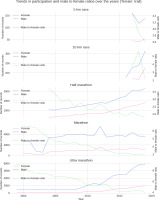
The men-to-women ratios by age group and race distances were presented below (Figure 7). the men- to-women ratios were increased across age groups in runners competing in both road and trail races. In road- based races, higher participation differences between sexes were shown for older marathoners (i.e., older than 70 years). For trail runs, older half-marathoners and participants in 10 km races showed a higher men- to-women ratio.
When the percent changes in running speed were assessed, a decline was shown in the race distances and age groups. the results also confirm that women were faster than men in 10 km trail races (Figure 8).
Discussion
This study intended to map running trends, including participation, gender, age group gaps, and performance in road and trail races within one country with the hypothesis of higher participation in short running distances (i.e., 5 km, 10 km) for women in road-based races. the main findings showed a higher frequency of runners competing in road-based races, although an increase in participation in trail running was shown for both sexes over time. For both terrains, the men- to-women ratio declined over time. In terms of performance, men had faster finishing times than women, except for the 10 km trail events, while athletes competing in road-based races presented faster finishing times than those competing in trail runs. Higher variability in race times was shown among runners of both sexes competing in trail runs.
Participation trends in running events were previously investigated [20, 21], considering sex, age, and race distance [22, 23]. our results align with the Running USA Annual report, which states that the number of finishers in U.S. running events has increased steadily over the past 20 years, with more than 17 million finishers in 2019 (www.runningintheusa.com). Among the participants, an increase in the number of women was previously demonstrated in different race distances [24, 25], as the 5 km race remains the most popular race distance. Despite the trend of an increasing participation over time, some race distances presented a decline in participation. Future studies should better explore these findings to understand the reasons for this decline, including if the decline is related to the need for travel to events or if it is a natural reduction in interest.
The findings of lower female participation rates in ultra-trails agree with the literature [26]. For instance, Mauvieux et al. [27] reported a 22% incidence in female participation in a 156 km trail run with a 6000 m elevation. It should be highlighted that - despite their smaller numbers in ultra-trail running - women tended to be higher achievers considering their higher percentage of successfully finished races [26].
Despite the higher popularity of road running, trail events have received more attention over the past years since some amateur runners use these events from a tourist perspective or as a strategy to be in contact with nature [28]. A report conducted on participation from 1984 to 2022 included 15.6 million race results and showed a growth of 231% in the last 10 years [29]. These findings also showed that marathoners from Switzerland were faster [29], which can explain the higher participation in marathon events in the present study since athletes can present a higher motivation to train and improve performance.
Our results confirmed previous findings where men presented faster finish times than women [30], which can be explained by several factors, including physiological, anatomical, and biomechanical differences [30]. Sex differences and age groups were previously discussed and included both individual and environmental factors [31]. The idea that women could outperform men in ultra-endurance events was presented before and was related to fat metabolism, pain tolerance, body size, and weight [32]. For example, McClelland et al. [33] showed that the sex differences in performance for short sprint running distances was smaller in shorter distances than in longer sprint distances. In our results, performance was similar between the sexes, with women outperforming men in the 10 km race distance. Factors explaining a better performance in women competing in 10 km running races can be related to a higher participation of well-trained women in these events and a higher participation of novice men in 10 km races. This is a new finding that should be explored in future studies.
Comparisons between road and trail terrains confirmed the hypothesis that runners competing in road runs are faster. Previous studies have yet to compare performances in both terrains; however, these results were expected due to the increased difficulty of navigating steep inclines and declines and the potential for technical terrain that requires careful footing and slower speeds in trail running [18]. Since both terrains present different characteristics, physiological demands also differ [18]. These characteristics also influence the higher variability in race times shown in trail running. In addition, higher variability was shown in women, especially those competing in 10 km running races. Factors that explain these findings can be related to differences in training experience in trail terrain, within age groups, and between genders [34]. As a part of training, environmental constraints, such as gender roles, perception of security, and available time should be considered [35, 36]. In addition, considering the role of fatigue in ultra-trail running [37], previous studies found that women may be more likely to experience fatigue and muscle damage during trail races compared to men [30]. This may be due to differences in muscle composition [30], hormonal profiles, and other physiological factors [30]. Interestingly, Chambers and Poidomani [38] emphasized the potential added benefit of exercising in nature - especially for the individual’s well-being - compared to the urban environment. Future studies using different methods should consider investigating the motivation and barriers associated with a woman’s participation in trail running.
Limitations of the present study include the lack of information about the events, such as the place in which they are held. Future studies should explore this information to track participation, including minorities, such as black and elderly people. In addition, differences in race course within and between terrains were not considered, but variability in race times can be related to race course characteristics. Another important limi- tation is the lack of information about the runners, especially their training background, that could help understand the higher variability in performance. the influence of weather was not considered [17]. our results can inform event organizers, coaches, and athletes about the trends and differences in participation and performance in road and trail races. Event organizers, trainers, and athletes could work together to create a more inclusive and supportive environment for women in trail events. this could entail offering training courses and materials that are especially geared toward women, encouraging women to participate in outdoor sports through marketing and outreach initiatives, and addressing safety issues and gender-related stereotypes. Future studies should address the barriers and motivations associated with women’s participation in trail events.
Conclusions
A higher frequency of men was shown for Swiss runners competing in both road and trail races, although the men-to-women ratio declined over time. Runners competing in road-based races were faster than those in trail runs, and trail runners presented a higher variability in finish times between genders and age groups.

